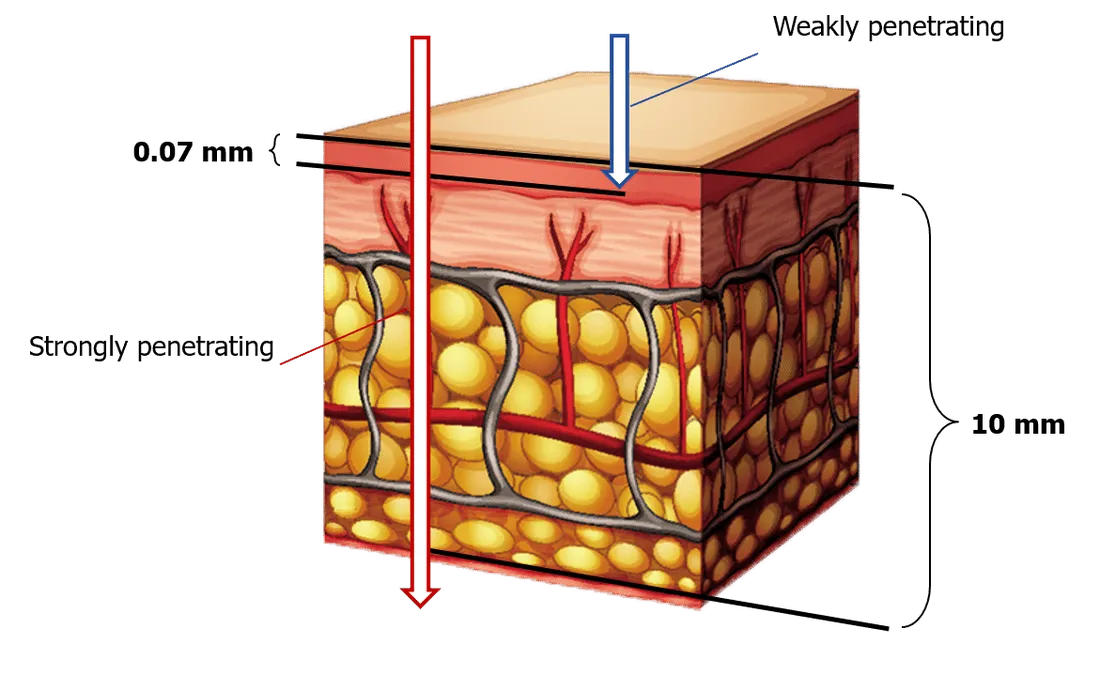To measure the emittance of contaminated surfaces one uses the concept of flux density. This is the number of particles that normally cross the unit area per unit of time. The flux density unit - 1/(s×m2) is such flux density when one particle traverses 1 second the area of 1 m2.
To measure the impact of ionizing radiation the absorbed dose concept is used. This is the average energy imparted to matter. The absorbed dose unit is gray (Gy); 1 Gy refers to the absorption of 1 J of ionizing radiation energy by 1 kg of matter.
Absorbed dose rate specifies the intensity of the radiation impact on matter; the rate of 1 Gy/s corresponds to the absorption of the radiation energy of 1 J by 1 kg of matter in 1 second.
In the band of absorbed dose values, when the radiation causes only stochastic effects, the differences between radiation impact on various human organs and tissues concerning types of ionizing radiation and tissue radiation sensitivity can be taken into account only based on expert estimates and evaluations. It is impossible to make direct experimental measurements of them.
That is why the so-called radiation protection quantities are introduced in the field of stochastic effects. They are briefed below.

Accounting a contribution of the type of radiation
All organs and tissues demonstrate different biological responses to different types of radiation. To take account of this difference the radiation weighting factor wR is introduced. The equivalent dose in an organ, or tissue (T) is defined as the product
HT = wR x DT,
of the average absorbed dose DT in the organ or tissue (organ dose), formed by the type of radiation (R), and wR is the weighting factor for this type of radiation.

Tissue radiosensitivity accounting
Human organs and tissues have different sensitivity to radiation. To take account of this difference the quantity named effective dose is introduced. The effective dose is equal to the sum over all human organs and tissues of products of the equivalent dose for each organ or tissue and corresponding tissue weighting factor wT:
Е = ΣТ (wT x HT)
The values of weighting factors wR and wT, established in Publication 103 of the International Commission on Radiological Protection (ICRP), are conservative and are intended to provide radiation protection.
To improve the conservative estimate of the equivalent dose in cases of radiation worker's individual dose and working place monitoring the simulating, so-called operational quantity named ambient dose equivalent is introduced. It is specially defined by the International Commission on Radiation Units and Measurements (ICRU), and this definition should be considered in measurement data processing in contemporary dosimeters.
Under Publication 103 of the International Commission on Radiological Protection issued in 2007, the following annual dose limits (radiation from man-made sources additional to the natural background) are stated:
| Type of Limit | Occupational | Public |
|---|---|---|
Effective dose | 20 mSv per year, averaged over defined periods of 5 yearse | 1 mSv in a yearf |
Annual equivalent dose in: | ||
Lens of the eyeb | 150 mSv | 15 mSv |
Skinc, d | 500 mSv | 50 mSv |
Hands and feet | 500 mSv | - |
a Limits on effective dose are for the sum of the relevant effective doses from external exposure in the specified period and the committed effective dose is computed for 50 years after intake, whereas for children it is computed for the period up to age 70 years.
b This limit is currently being reviewed by an ICRP Task Group.
c The limitation on effective dose provides sufficient protection for the skin against stochastic effects.
d Averaged over 1 cm2 area of skin regardless of the area exposed.
e With the further provision that the effective dose should not exceed 50 mSv in any single year. Additional restrictions apply to the occupational exposure of pregnant women.
f In special circumstances, a higher value of effective dose could be allowed in a single year, provided that the average over 5 years does not exceed 1 mSv per year.

Exposure
- When an individual dose exceeds 100 Gy immediate death (in the first hours) takes place because of the permanent damage of nervous cells (cerebral syndrome).
- The doses of 50-100 Gy lead to death in 5-6 days after exposure.
- Intestinal radiation damage (gastrointestinal syndrome) is observed when the absorbed radiation dose varies in the interval of 10-50 Gy and leads to death on days 10-14.
The typical form of radiation disease develops at 1-10 Gy. The absorbed dose of 3-5 Gy leads to the death of 50% of exposed people during 30 days if one does not undertake specific medical measures.
The exposed patients dwell in sterile conditions, they are exposed to blood transfusion, and their bone marrow transplantation is carried out to revive the blood production system. All these curing measures are entertained together with the administration of strengthening and anti-inflammatory remedies.
The shares of different components of annual exposure from natural background at an average total annual dose of 3 mSv (external and internal radiation) are shown.
